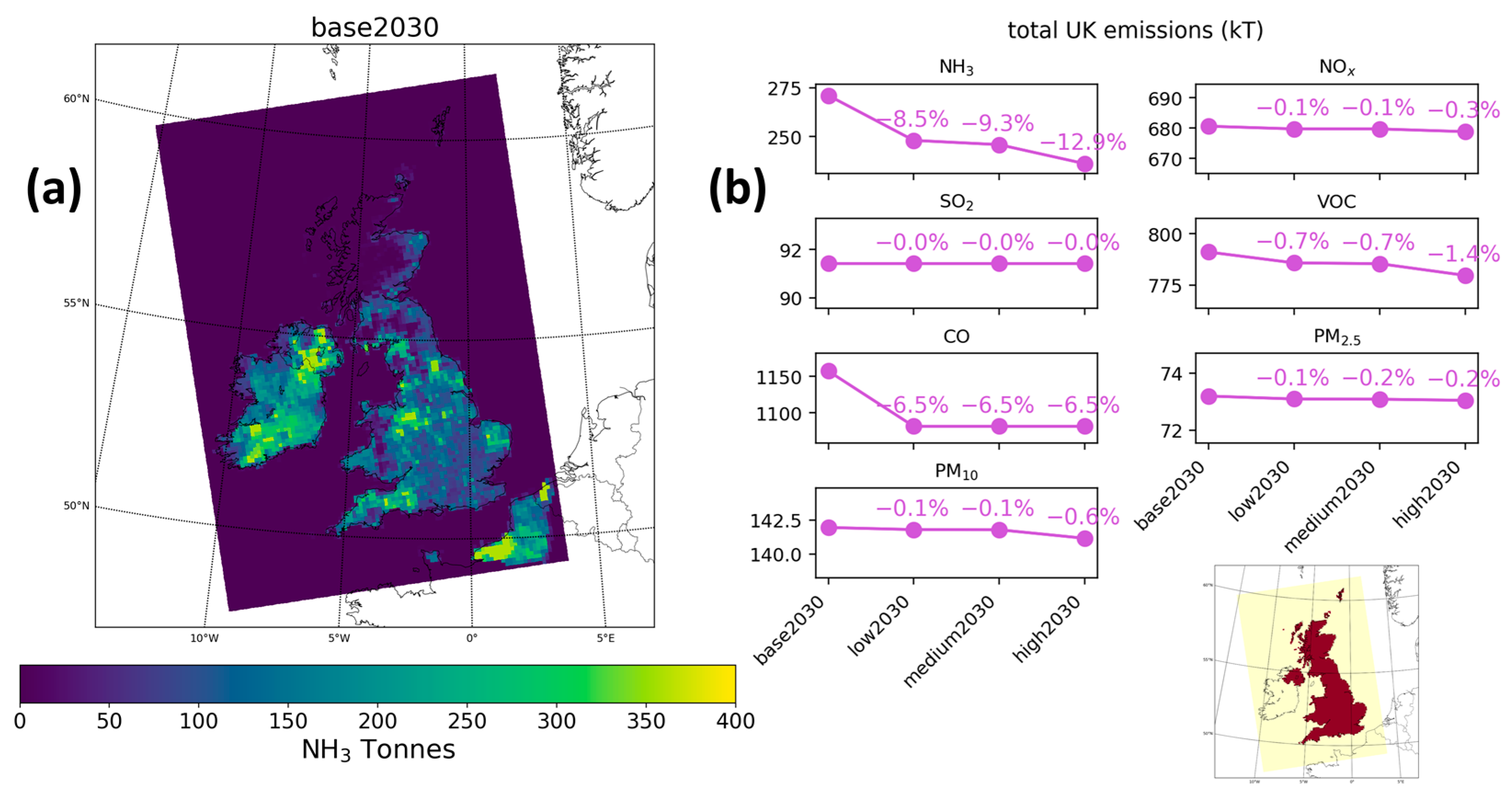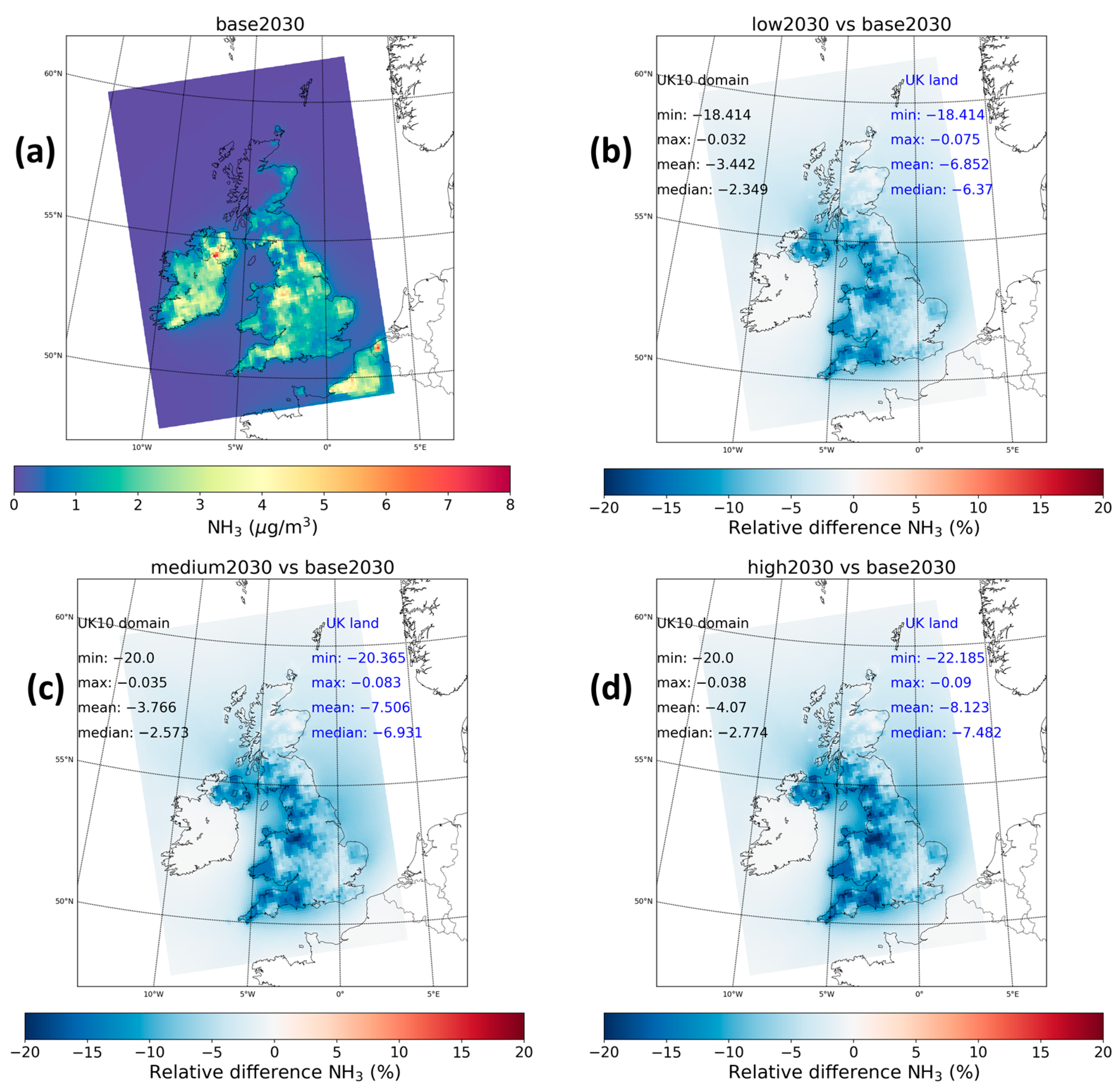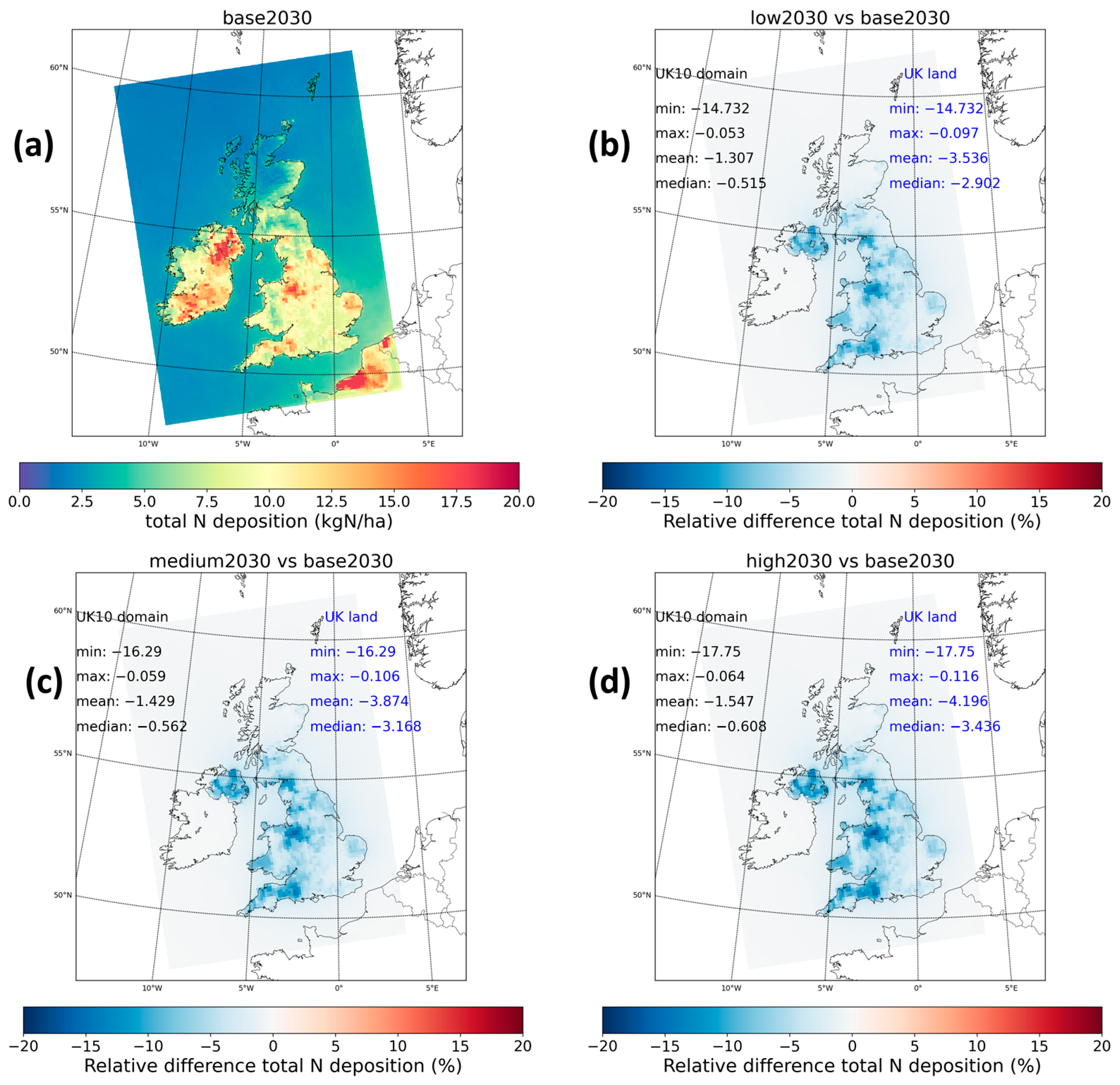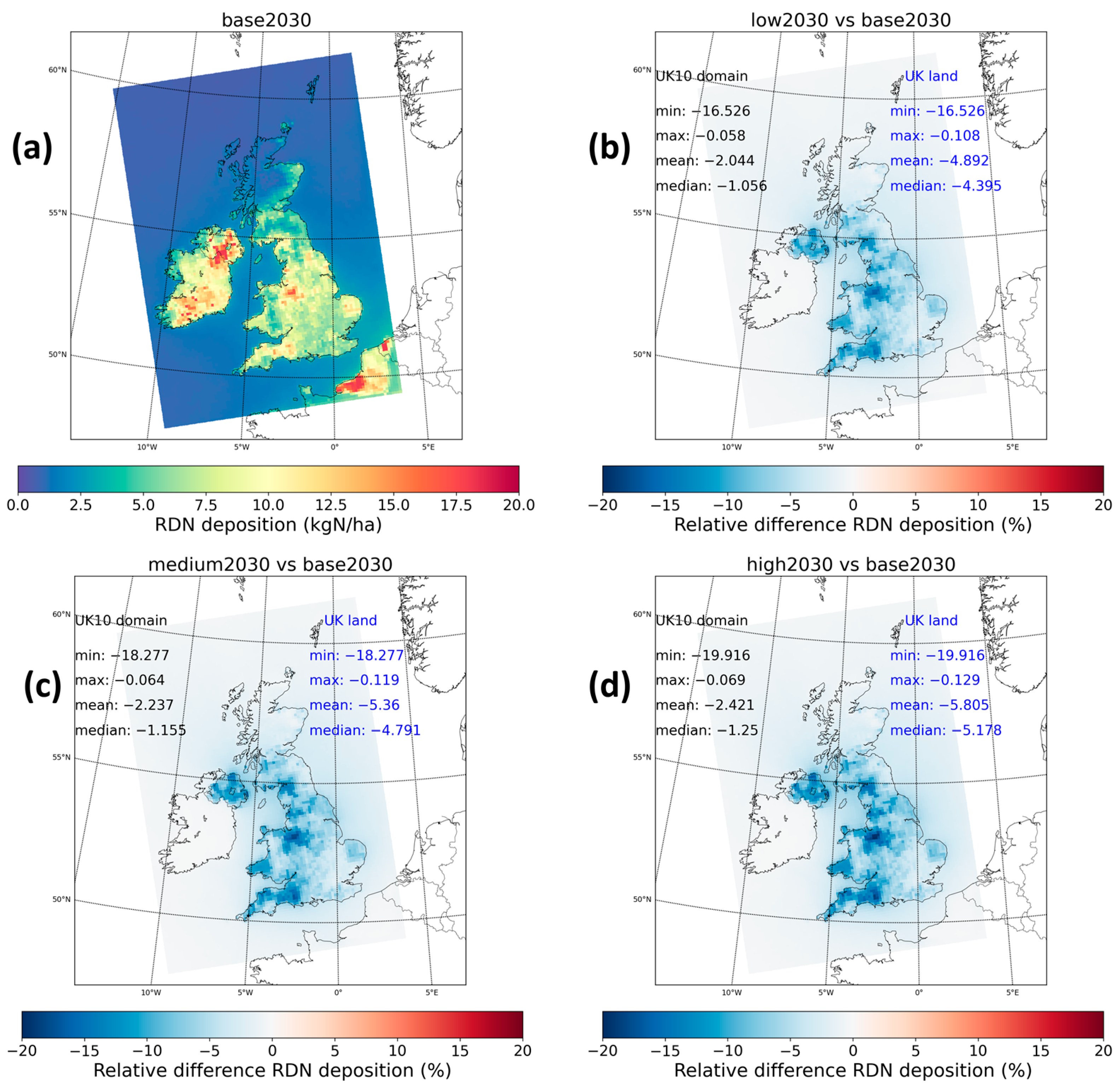The Impact of Farming Mitigation Measures on Ammonia Concentrations and Nitrogen Deposition in the UK
Abstract
:1. Introduction
2. Methodology
2.1. Model Set-Up
2.2. Emission Scenarios
3. Evaluation
4. Analysis on Predictions
4.1. NH3 Concentrations
4.2. N Deposition
5. Conclusions
Supplementary Materials
Author Contributions
Funding
Institutional Review Board Statement
Informed Consent Statement
Data Availability Statement
Acknowledgments
Conflicts of Interest
Appendix A. Statistics Used
References
- Misselbrook, T.H.; Gilhespy, S.L.; Carswell, A.M.; Cardenas, L.M. Inventory of Ammonia Emissions from UK Agriculture 2021; Rothamsted Research: Harpenden, UK, 2023. [Google Scholar]
- Hauglustaine, D.A.; Balkanski, Y.; Schulz, M. A Global Model Simulation of Present and Future Nitrate Aerosols and Their Direct Radiative Forcing of Climate. Atmos. Chem. Phys. 2014, 14, 11031–11063. [Google Scholar] [CrossRef]
- Dammers, E.; McLinden, C.A.; Griffin, D.; Shephard, M.W.; Van Der Graaf, S.; Lutsch, E.; Schaap, M.; Gainairu-Matz, Y.; Fioletov, V.; Van Damme, M.; et al. NH3 Emissions from Large Point Sources Derived from CrIS and IASI Satellite Observations. Atmos. Chem. Phys. 2019, 19, 12261–12293. [Google Scholar] [CrossRef]
- Abeed, R.; Viatte, C.; Porter, W.C.; Evangeliou, N.; Clerbaux, C.; Clarisse, L.; Van Damme, M.; Coheur, P.-F.; Safieddine, S. A Roadmap to Estimating Agricultural Ammonia Volatilization over Europe Using Satellite Observations and Simulation Data. Atmos. Chem. Phys. 2023, 23, 12505–12523. [Google Scholar] [CrossRef]
- Xie, Y.; Wang, W.; Chen, Y.; Qian, Z.; Chen, J.; Tong, J.; Li, L.; Yue, Y.; Chen, K.; Chu, Z.; et al. NH3 Emissions and Lifetime Estimated by Satellite Observations with Differential Evolution Algorithm. Atmosphere 2024, 15, 251. [Google Scholar] [CrossRef]
- Gu, B.; Zhang, L.; Van Dingenen, R.; Vieno, M.; Van Grinsven, H.J.; Zhang, X.; Zhang, S.; Chen, Y.; Wang, S.; Ren, C.; et al. Abating Ammonia Is More Cost-Effective than Nitrogen Oxides for Mitigating PM2.5 Air Pollution. Science 2021, 374, 758–762. [Google Scholar] [CrossRef] [PubMed]
- Wyer, K.E.; Kelleghan, D.B.; Blanes-Vidal, V.; Schauberger, G.; Curran, T.P. Ammonia Emissions from Agriculture and Their Contribution to Fine Particulate Matter: A Review of Implications for Human Health. J. Environ. Manag. 2022, 323, 116285. [Google Scholar] [CrossRef]
- Pope, C.A.; Dockery, D.W. Health Effects of Fine Particulate Air Pollution: Lines That Connect. J. Air Waste Manag. Assoc. 2006, 56, 709–742. [Google Scholar] [CrossRef]
- Kim, K.-H.; Kabir, E.; Kabir, S. A Review on the Human Health Impact of Airborne Particulate Matter. Environ. Int. 2015, 74, 136–143. [Google Scholar] [CrossRef]
- Kharol, S.K.; Shephard, M.W.; McLinden, C.A.; Zhang, L.; Sioris, C.E.; O’Brien, J.M.; Vet, R.; Cady-Pereira, K.E.; Hare, E.; Siemons, J.; et al. Dry Deposition of Reactive Nitrogen From Satellite Observations of Ammonia and Nitrogen Dioxide Over North America. Geophys. Res. Lett. 2018, 45, 1157–1166. [Google Scholar] [CrossRef]
- Liu, X.; Tai, A.P.K.; Fung, K.M. Responses of Surface Ozone to Future Agricultural Ammonia Emissions and Subsequent Nitrogen Deposition through Terrestrial Ecosystem Changes. Atmos. Chem. Phys. 2021, 21, 17743–17758. [Google Scholar] [CrossRef]
- Ge, Y.; Vieno, M.; Stevenson, D.S.; Wind, P.; Heal, M.R. Global Sensitivities of Reactive N and S Gas and Particle Concentrations and Deposition to Precursor Emissions Reductions. Atmos. Chem. Phys. 2023, 23, 6083–6112. [Google Scholar] [CrossRef]
- Sun, J.; Fu, J.S.; Lynch, J.A.; Huang, K.; Gao, Y. Climate-driven Exceedance of Total (Wet + Dry) Nitrogen (N) + Sulfur (S) Deposition to Forest Soil over the Conterminous U.S. Earth’s Future 2017, 5, 560–576. [Google Scholar] [CrossRef]
- Ge, Y.; Vieno, M.; Stevenson, D.S.; Wind, P.; Heal, M.R. A New Assessment of Global and Regional Budgets, Fluxes, and Lifetimes of Atmospheric Reactive N and S Gases and Aerosols. Atmos. Chem. Phys. 2022, 22, 8343–8368. [Google Scholar] [CrossRef]
- Department for Environment Food & Rural Affairs Accredited Official Statistics, Emissions of Air Pollutants in the UK—Background. Available online: https://www.gov.uk/government/statistics/emissions-of-air-pollutants/emissions-of-air-pollutants-in-the-uk-background (accessed on 18 March 2025).
- Wiltshire, J.; Misselbrook, T.; Cowie, H.; Dixon, K.; Conlan, B.; Williamson, T.; Vardoulakis, S. Rapid Evidence Assessment of Interventions to Improve Ambient Air Quality: Agricultural/Rural Interventions; Public Health England: Edinburgh, UK, 2018. [Google Scholar]
- Byun, D.; Schere, K.L. Review of the Governing Equations, Computational Algorithms, and Other Components of the Models-3 Community Multiscale Air Quality (CMAQ) Modeling System. Appl. Mech. Rev. 2006, 59, 51–77. [Google Scholar] [CrossRef]
- Appel, K.W.; Bash, J.O.; Fahey, K.M.; Foley, K.M.; Gilliam, R.C.; Hogrefe, C.; Hutzell, W.T.; Kang, D.; Mathur, R.; Murphy, B.N.; et al. The Community Multiscale Air Quality (CMAQ) Model Versions 5.3 and 5.3.1: System Updates and Evaluation. Geosci. Model Dev. 2021, 14, 2867–2897. [Google Scholar] [CrossRef]
- Jenkins, B.; Wiltshire, J. Farmer Perceptions of the Benefits and Barriers to Ammonia Mitigation Measures. NIHR J. 2024, in press. [Google Scholar]
- US EPA Office of Research and Development. CMAQ 2022. Available online: https://zenodo.org/records/7218076 (accessed on 17 December 2024).
- Luecken, D.J.; Yarwood, G.; Hutzell, W.T. Multipollutant Modeling of Ozone, Reactive Nitrogen and HAPs across the Continental US with CMAQ-CB6. Atmos. Environ. 2019, 201, 62–72. [Google Scholar] [CrossRef]
- Pye, H.O.T.; Murphy, B.N.; Xu, L.; Ng, N.L.; Carlton, A.G.; Guo, H.; Weber, R.; Vasilakos, P.; Appel, K.W.; Budisulistiorini, S.H.; et al. On the Implications of Aerosol Liquid Water and Phase Separation for Organic Aerosol Mass. Atmos. Chem. Phys. 2017, 17, 343–369. [Google Scholar] [CrossRef]
- Iacono, M.J.; Delamere, J.S.; Mlawer, E.J.; Shephard, M.W.; Clough, S.A.; Collins, W.D. Radiative Forcing by Long-lived Greenhouse Gases: Calculations with the AER Radiative Transfer Models. J. Geophys. Res. 2008, 113, 2008JD009944. [Google Scholar] [CrossRef]
- Dudhia, J. Numerical Study of Convection Observed during the Winter Monsoon Experiment Using a Mesoscale Two-Dimensional Model. J. Atmos. Sci. 1989, 46, 3077–3107. [Google Scholar] [CrossRef]
- Pleim, J.E. A Combined Local and Nonlocal Closure Model for the Atmospheric Boundary Layer. Part II: Application and Evaluation in a Mesoscale Meteorological Model. J. Appl. Meteorol. Climatol. 2007, 46, 1396–1409. [Google Scholar] [CrossRef]
- Pleim, J.E. A Combined Local and Nonlocal Closure Model for the Atmospheric Boundary Layer. Part I: Model Description and Testing. J. Appl. Meteorol. Climatol. 2007, 46, 1383–1395. [Google Scholar] [CrossRef]
- Pleim, J.E. A Simple, Efficient Solution of Flux–Profile Relationships in the Atmospheric Surface Layer. J. Appl. Meteorol. Climatol. 2006, 45, 341–347. [Google Scholar] [CrossRef]
- Smirnova, T.G.; Brown, J.M.; Benjamin, S.G.; Kenyon, J.S. Modifications to the Rapid Update Cycle Land Surface Model (RUC LSM) Available in the Weather Research and Forecasting (WRF) Model. Mon. Wea. Rev. 2016, 144, 1851–1865. [Google Scholar] [CrossRef]
- Kain, J.S. The Kain–Fritsch Convective Parameterization: An Update. J. Appl. Meteor. 2004, 43, 170–181. [Google Scholar] [CrossRef]
- Hogrefe, C.; Bash, J.O.; Pleim, J.E.; Schwede, D.B.; Gilliam, R.C.; Foley, K.M.; Appel, K.W.; Mathur, R. An Analysis of CMAQ Gas-Phase Dry Deposition over North America through Grid-Scale and Land-Use-Specific Diagnostics in the Context of AQMEII4. Atmos. Chem. Phys. 2023, 23, 8119–8147. [Google Scholar] [CrossRef] [PubMed]
- Pleim, J.E.; Ran, L.; Appel, W.; Shephard, M.W.; Cady-Pereira, K. New Bidirectional Ammonia Flux Model in an Air Quality Model Coupled With an Agricultural Model. J. Adv. Model. Earth Syst. 2019, 11, 2934–2957. [Google Scholar] [CrossRef]
- Pleim, J.; Ran, L. Surface Flux Modeling for Air Quality Applications. Atmosphere 2011, 2, 271–302. [Google Scholar] [CrossRef]
- Guenther, A.; Jiang, X.; Shah, T.; Huang, L.; Kemball-Cook, S.; Yarwood, G. Model of Emissions of Gases and Aerosol from Nature Version 3 (MEGAN3) for Estimating Biogenic Emissions. In Air Pollution Modeling and its Application XXVI; Mensink, C., Gong, W., Hakami, A., Eds.; Springer Proceedings in Complexity; Springer International Publishing: Cham, Switzerland, 2020; pp. 187–192. ISBN 978-3-030-22054-9. [Google Scholar]
- Kendon, M.; McCarthy, M.; Jevrejeva, S.; Matthews, A.; Sparks, T.; Garforth, J. State of the UK Climate 2019. Int. J. Climatol. 2020, 40, 1–69. [Google Scholar] [CrossRef]
- Morcrette, J.-J.; Boucher, O.; Jones, L.; Salmond, D.; Bechtold, P.; Beljaars, A.; Benedetti, A.; Bonet, A.; Kaiser, J.W.; Razinger, M.; et al. Aerosol Analysis and Forecast in the European Centre for Medium-Range Weather Forecasts Integrated Forecast System: Forward Modeling. J. Geophys. Res. 2009, 114, 2008JD011235. [Google Scholar] [CrossRef]
- USEPA CMAQ—BCON. Available online: https://github.com/USEPA/CMAQ/tree/main/PREP/bcon (accessed on 17 December 2024).
- EMEP Gridded-Emissions. Available online: https://www.ceip.at/the-emep-grid/gridded-emissions (accessed on 17 December 2024).
- ECLIPSE V6b; Global Emission Fields of Air Pollutants and GHGs. 2019. Available online: https://Iiasa.Ac.at/Models-Tools-Data/Global-Emission-Fields-of-Air-Pollutants-and-Ghgs (accessed on 17 December 2024).
- Ricardo SMT: Designing a Scenario-Modelling Tool to Inform Policy on Air Pollutant Emissions. Available online: https://www.ricardo.com/en/case-studies/designing-a-scenario-modelling-tool-to-inform-policy-on-air-pollutant-emissions (accessed on 17 December 2024).
- Churchill, S.; Misra, A.; Brown, P.; Del Vento, S.; Karagianni, E.; Murrells, T.; Passant, N.; Richardson, J.; Richmond, B.; Smith, H.; et al. UK Informative Inventory Report (1990 to 2019); Ricardo Energy Environment: Oxfordshire, UK, 2021. [Google Scholar]
- Pommier, M.; Benney, R.; Bost, J.; Jenkins, B.; Richardson, J.; Rock, L.; Blythe, O.; Marshall, O.; Spence, A. Impact of Agricultural Interventions on Air Pollutants’ Emissions, and Human Exposure to PM2.5 Concentrations in the UK. NIHR J. 2024, in press. [Google Scholar]
- UK AIR. Available online: https://Uk-Air.Defra.Gov.Uk/Data/Data_selector_service (accessed on 20 December 2024).
- Marais, E.A.; Pandey, A.K.; Van Damme, M.; Clarisse, L.; Coheur, P.; Shephard, M.W.; Cady-Pereira, K.E.; Misselbrook, T.; Zhu, L.; Luo, G.; et al. UK Ammonia Emissions Estimated With Satellite Observations and GEOS-Chem. JGR Atmos. 2021, 126, e2021JD035237. [Google Scholar] [CrossRef]
- Kelly, J.M.; Marais, E.A.; Lu, G.; Obszynska, J.; Mace, M.; White, J.; Leigh, R.J. Diagnosing Domestic and Transboundary Sources of Fine Particulate Matter (PM2.5) in UK Cities Using GEOS-Chem. City Environ. Interact. 2023, 18, 100100. [Google Scholar] [CrossRef]
- Pay, M.T.; Jiménez-Guerrero, P.; Baldasano, J.M. Assessing Sensitivity Regimes of Secondary Inorganic Aerosol Formation in Europe with the CALIOPE-EU Modeling System. Atmos. Environ. 2012, 51, 146–164. [Google Scholar] [CrossRef]
- Ansari, A.S.; Pandis, S.N. Response of Inorganic PM to Precursor Concentrations. Environ. Sci. Technol. 1998, 32, 2706–2714. [Google Scholar] [CrossRef]
- Pan, D.; Mauzerall, D.L.; Wang, R.; Guo, X.; Puchalski, M.; Guo, Y.; Song, S.; Tong, D.; Sullivan, A.P.; Schichtel, B.A.; et al. Regime Shift in Secondary Inorganic Aerosol Formation and Nitrogen Deposition in the Rural United States. Nat. Geosci. 2024, 17, 617–623. [Google Scholar] [CrossRef] [PubMed]
- Jonson, J.E.; Fagerli, H.; Scheuschner, T.; Tsyro, S. Modelling Changes in Secondary Inorganic Aerosol Formation and Nitrogen Deposition in Europe from 2005 to 2030. Atmos. Chem. Phys. 2022, 22, 1311–1331. [Google Scholar] [CrossRef]
- Clappier, A.; Thunis, P.; Beekmann, M.; Putaud, J.P.; De Meij, A. Impact of SOx, NOx and NH3 Emission Reductions on PM2.5 Concentrations across Europe: Hints for Future Measure Development. Environ. Int. 2021, 156, 106699. [Google Scholar] [CrossRef]
- Marais, E.A.; Kelly, J.M.; Vohra, K.; Li, Y.; Lu, G.; Hina, N.; Rowe, E.C. Impact of Legislated and Best Available Emission Control Measures on UK Particulate Matter Pollution, Premature Mortality, and Nitrogen-Sensitive Habitats. GeoHealth 2023, 7, e2023GH000910. [Google Scholar] [CrossRef]
- Pastorino, S.; Milojevic, A.; Green, R.; Beck, R.; Carnell, E.; Colombo, P.E.; Misselbrook, T.; Miller, M.; Reis, S.; Tomlinson, S.; et al. Health Impact of Policies to Reduce Agriculture-Related Air Pollutants in the UK: The Relative Contribution of Change in PM2.5 Exposure and Diets to Morbidity and Mortality. Environ. Res. 2024, 262, 119923. [Google Scholar] [CrossRef]
- Mueller, W.; Carson, F.; Dubey, J.; Gutierrez, A.; O’Hare, E.; Cowie, H. Agricultural Interventions to Reduce PM2.5 in the UK: Impacts on Health and the Economy. NIHR J. 2024, in press. [Google Scholar]
- Fu, X.; Wang, S.X.; Ran, L.M.; Pleim, J.E.; Cooter, E.; Bash, J.O.; Benson, V.; Hao, J.M. Estimating NH3 Emissions from Agricultural Fertilizer Application in China Using the Bi-Directional CMAQ Model Coupled to an Agro-Ecosystem Model. Atmos. Chem. Phys. 2015, 15, 6637–6649. [Google Scholar] [CrossRef]









Disclaimer/Publisher’s Note: The statements, opinions and data contained in all publications are solely those of the individual author(s) and contributor(s) and not of MDPI and/or the editor(s). MDPI and/or the editor(s) disclaim responsibility for any injury to people or property resulting from any ideas, methods, instructions or products referred to in the content. |
© 2025 by the authors. Licensee MDPI, Basel, Switzerland. This article is an open access article distributed under the terms and conditions of the Creative Commons Attribution (CC BY) license (https://creativecommons.org/licenses/by/4.0/).
Share and Cite
Pommier, M.; Bost, J.; Lewin, A.; Richardson, J. The Impact of Farming Mitigation Measures on Ammonia Concentrations and Nitrogen Deposition in the UK. Atmosphere 2025, 16, 353. https://doi.org/10.3390/atmos16040353
Pommier M, Bost J, Lewin A, Richardson J. The Impact of Farming Mitigation Measures on Ammonia Concentrations and Nitrogen Deposition in the UK. Atmosphere. 2025; 16(4):353. https://doi.org/10.3390/atmos16040353
Chicago/Turabian StylePommier, Matthieu, Jamie Bost, Andrew Lewin, and Joe Richardson. 2025. "The Impact of Farming Mitigation Measures on Ammonia Concentrations and Nitrogen Deposition in the UK" Atmosphere 16, no. 4: 353. https://doi.org/10.3390/atmos16040353
APA StylePommier, M., Bost, J., Lewin, A., & Richardson, J. (2025). The Impact of Farming Mitigation Measures on Ammonia Concentrations and Nitrogen Deposition in the UK. Atmosphere, 16(4), 353. https://doi.org/10.3390/atmos16040353






